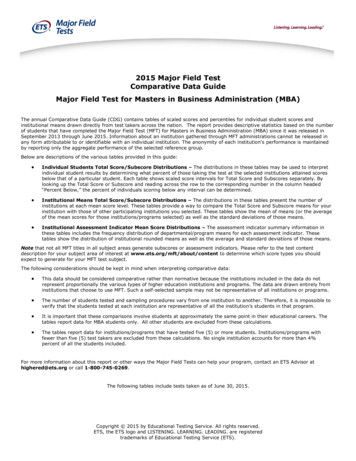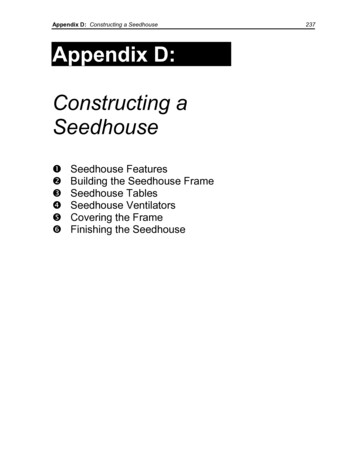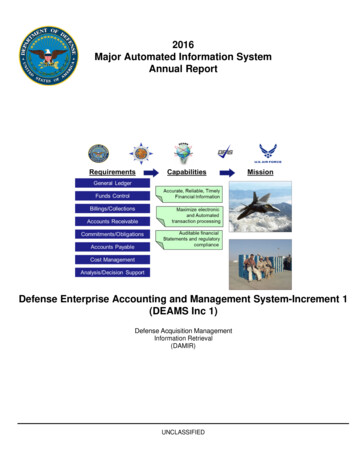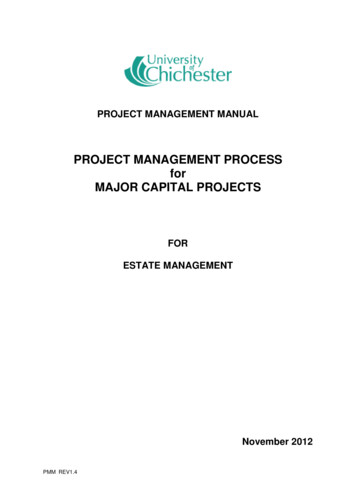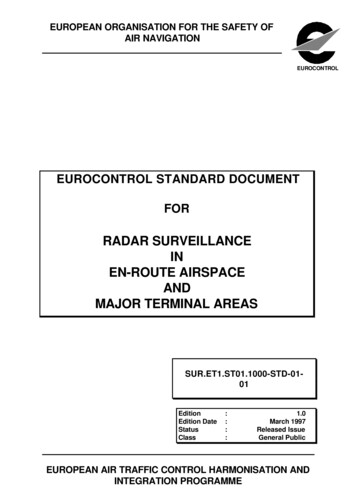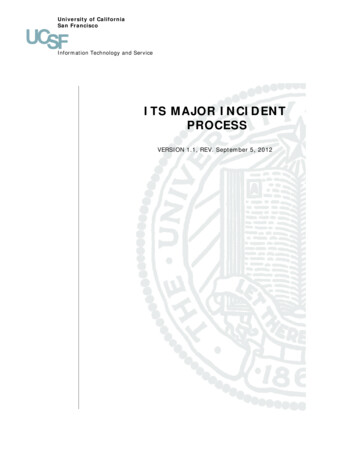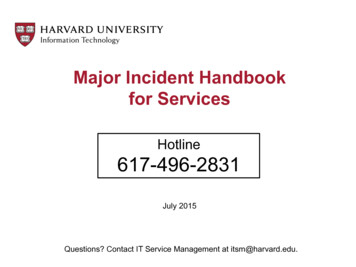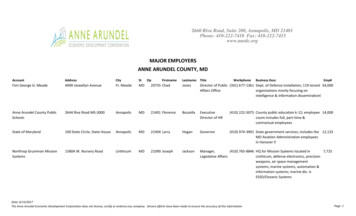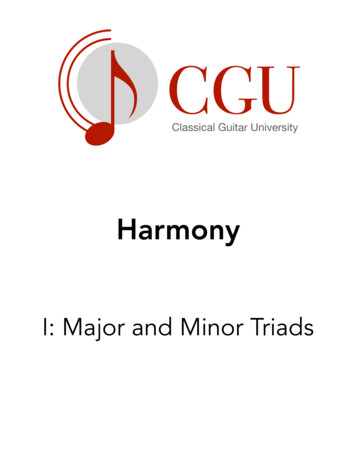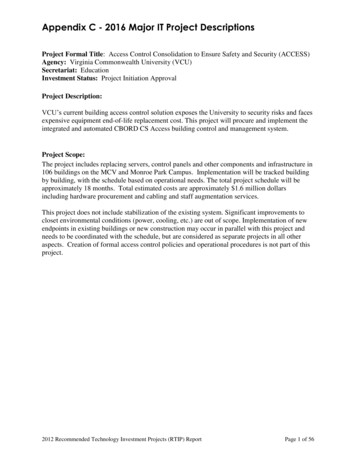
Transcription
Appendix C - 2016 Major IT Project DescriptionsProject Formal Title: Access Control Consolidation to Ensure Safety and Security (ACCESS)Agency: Virginia Commonwealth University (VCU)Secretariat: EducationInvestment Status: Project Initiation ApprovalProject Description:VCU’s current building access control solution exposes the University to security risks and facesexpensive equipment end-of-life replacement cost. This project will procure and implement theintegrated and automated CBORD CS Access building control and management system.Project Scope:The project includes replacing servers, control panels and other components and infrastructure in106 buildings on the MCV and Monroe Park Campus. Implementation will be tracked buildingby building, with the schedule based on operational needs. The total project schedule will beapproximately 18 months. Total estimated costs are approximately 1.6 million dollarsincluding hardware procurement and cabling and staff augmentation services.This project does not include stabilization of the existing system. Significant improvements tocloset environmental conditions (power, cooling, etc.) are out of scope. Implementation of newendpoints in existing buildings or new construction may occur in parallel with this project andneeds to be coordinated with the schedule, but are considered as separate projects in all otheraspects. Creation of formal access control policies and operational procedures is not part of thisproject.2012 Recommended Technology Investment Projects (RTIP) ReportPage 1 of 56
Appendix C - 2016 Major IT Project DescriptionsProject Formal Title: Audit Case Management Mobile SystemAgency: Department of Taxation (TAX)Secretariat: FinanceInvestment Status: Investment Business Case ApprovalProject Description:The Case Management system will allow TAX field staff (auditors) to use tablets. The tabletswould have an audit application that would replace Tax’s existing audit case management andaudit workbench applications. These existing applications are dated. Auditors could connectwherever a cell signal was available. The applications would have the ability to workdisconnected in the event there is no cell signal available. The system will have the ability toaccept a credit/debit card or electronic check, and the ability to exchange encrypted electronicdocuments with taxpayers. The system will integrate directly with Tax’s core applicationAdvantage Revenue (AR) so audit returns could be loaded automatically with the appropriatecompliance code and no additional involvement by other staff.Project Scope:As a result of providing this functionality TAX collectors and auditors will be able to offer onestop service to our customers as well as multiple payment options. Currently, pay by paper checkis the only option provided to customers. By allowing electronic payments, funds will beavailable sooner.TAX reps will be able to process payments and tax returns electronically and have theconfirmation of the filing and the payment emailed to the taxpayer. This presents an opportunityfor educating the taxpayer and achieving the Commonwealth/TAX goals for electronic filing andpayment. This would decrease paperwork for the agent and save TAX time and money becausefunds will be processed to the bank more efficiently, no delays or costs for mailing and eliminatethe need to process paper returns or checks.2016 Recommended Technology Investment Projects (RTIP) ReportPage 2 of 56
Appendix C - 2016 Major IT Project DescriptionsProject Formal Title: Cardinal PayrollAgency: Department of Accounts (DOA)Secretariat: FinanceInvestment Status: Project Initiation ApprovalProject Description:Cardinal is the Commonwealth's Enterprise Resource Planning (ERP) system for administrativesystems. It is based on Oracle's PeopleSoft software. Cardinal has implemented financialmodules via several system rollouts at Virginia Department of Transportation (VDOT),Department of Accounts (DOA), 140 agencies (Wave 1 of Statewide Rollout) and is in theprocess of implementing Cardinal at another 134 agencies as part of Wave 2 of the StatewideRollout of financials. The Commonwealth's current Payroll system is CIPPS. CIPPS wasimplemented in the mid-1980s. It is a purchased software package supported by Infor GlobalSolutions (formerly McCormack and Dodge, Dun and Bradstreet, and GEAC). The currentapplication runs on the IBM mainframe and is written in COBOL. Infor has announced technicalsupport for the application will end May 31, 2018. Given that most of the staff used to maintainCIPPS are also of retirement age, the Commonwealth must move forward with a new payrollsolution. The Commonwealth will expand the Cardinal system to include the necessaryPeopleSoft modules to meet the payroll functional requirements. This will result in the design,development, test and deployment of a new payroll system to over 200 state agencies. At theend of this implementation, CIPPS will be retired.Project Scope:The CIPPS Replacement project scope includes replacing a purchased software packageimplemented in the mid-1980s, which runs on the IBM mainframe and is supported by InforGlobal Solutions. This project request is to define new system requirements, develop andimplement the new system and train the users of 200 agencies and central support staff.The planning phase (March 2015 - August 2016) clearly defined the business requirements forthe Commonwealth. These requirements will drive the scope of the project, including thesoftware modules that will be implemented (Payroll, Time and Attendance, AbsenceManagement). Additionally, some core HR and Benefits processes will have to be implementedin Cardinal to support interfaces from other central agencies and to ensure that the PeopleSoftPayroll processes work correctly. This project will NOT replace the state's current HR (PMIS)or Benefits (BES) systems administered by DHRM.The implementation will have full design, build, test and deployment phases of work and will bestaffed by COV and Accenture resources over a 28 month period. The project will have twoReleases, with 25% of the users going live in the Release 1 and the remaining going live inRelease2. Scope includes data conversion, central and line agency interface development, thirdparty interface development, a comprehensive change leadership program and a user base of 120,000 current and former employees.2016 Recommended Technology Investment Projects (RTIP) ReportPage 3 of 56
Appendix C - 2016 Major IT Project DescriptionsProject Formal Title: Cardinal UpgradeAgency: Department of Accounts (DOA)Secretariat: FinanceInvestment Status: Project Initiation ApprovalProject Description:This effort will result in an upgrade to the recently deployed statewide accounting system,Cardinal. The solution is a system upgrade to Oracle's PeopleSoft Enterprise Resource Planning(ERP), the underlying toolset, the Oracle database, the operating system and the hardware usedto run the application. This complete refresh will be completed by a combination of Cardinal,VITA/NG and Accenture Upgrade Lab staff over the next twelve months. The approachincludes a proven and disciplined methodology for upgrading PeopleSoft and has beensuccessfully used in several other states that DOA has regular contact with. Because it is aproven approach and is being completed by Cardinal-experienced resources, there will be areduction in both costs and risks.Project Scope:The Cardinal Upgrade Project includes upgrading the solutions hardware, operating system,database, supporting toolset and application software to currently supported versions. This isconsidered a technical upgrade and no new functionality or business processes are beingintroduced as part of this upgrade. Impacts to end users will be limited to training materialupdates (new screen shots) and potentially the regression testing of some interfaces. The projectupgrade is required for future project implementations, but any approved future implementationswill be tracked as distinct projects.2016 Recommended Technology Investment Projects (RTIP) ReportPage 4 of 56
Appendix C - 2016 Major IT Project DescriptionsProject Formal Title: Construction Documentation ManagementAgency: Department of Transportation (VDOT)Secretariat: TransportationInvestment Status: Project Initiation ApprovalProject Description:The Construction Documentation Management project will develop standardized businessprocess workflows that will automate the creation, storage and status designation of constructiondocuments. The project will allow personnel to step through designated workflows, storeconstruction documents in a standard SharePoint repository with a standard set of documentfolders at each level of the construction process, from final design through the end ofconstructions.Project Scope:The Construction Documentation Management project scope will include a commonenvironment to give VDOT consultants and contractors system access and enhanced documentcollaboration between all project resources. The project will also allow VDOT to streamlinecurrent processes and to establish standard automated business process flows for constructiondocument management. This allows VDOT to incorporate consistent, best-practice workflows toaccelerate accurate document management to meet critical business schedules during the design,procurement and construction phases of VDOT projects.This systems development project will focus on the contracting and construction phases, anddoes not include the preliminary design phase of a construction project and its documents.2016 Recommended Technology Investment Projects (RTIP) ReportPage 5 of 56
Appendix C - 2016 Major IT Project DescriptionsProject Formal Title: Customer Portal – Integrated RegistrationAgency: Virginia Employment Commission (VEC)Secretariat: Commerse and TradeInvestment Status: Project Iniation ApprovalProject Description:This investment supports activities of the Virginia Unemployment Insurance (UI) Act and theWorkforce Services Division (WSD).The project will create an online portal for registration to UI and WSD services offered by theVEC. The portal will collect personal identifying information, authenticate this information, andcreate a single sign-on for the user to the separate systems of Unemployment Insurance and JobService.The collected information will be stored on a secure environment and will pre-populate requiredfields for registering with the UI and WSD systems.Project Scope:In order to meet Workforce Innovation and Opportunity Act (WIOA) implementationrequirements and deadlines as outlined in the Virginia WIOA Combined State Plan, the VirginiaEmployment Commission (VEC) requires integrated software enhancements to the current webbased workforce system, the Geographic Solutions Virtual One Stop (VOS) application.Geographic Solutions, Inc. is currently under contract (VCCS-WDS-SS-13-021) to provide VOSto the Commonwealth’ workforce customers. The VOS System is the Commonwealth’s Systemof Record for Wagner-Peyser, Trade Act and WIOA.Periodically, and usually in response to changes in federal law or regulations, GeographicSolutions makes available to their customers enhancements to the VOS system. Theseenhancements are proprietary software solutions. We are unaware of any vendor in themarketplace who has the ability to make authorized changes to the Geographic Solutions, Inc.Virtual One Stop product.Geographic Solutions has developed proprietary enhancements to the VOS system that provide apractical, cost-effective and integrated solution that meets the requirements of theCommonwealth. The enhancements are currently available for purchase to their customers.Additionally, under the current contract, the vendor is obligated to provide warranty for theSolution in production. During this warranty period, unauthorized changes introduced by anyparty could nullify the vendor’s warranty obligations. As such, it is in the best interest of theVCCS and the Commonwealth to continue using this vendor for additions and changes to theproduction proprietary solution.In order to integrate the Commonwealth’s Unemployment Insurance and Wagner-Peyser systemsin compliance with State and Federal WIOA requirements, the VEC proposes to purchase anddeploy the proprietary system functionality enhancements made available by GeographicSolutions as an integrated add-on to the current system.2016 Recommended Technology Investment Projects (RTIP) ReportPage 6 of 56
Appendix C - 2016 Major IT Project DescriptionsProject Formal Title: Division of Disease Prevention (DDP) STDMIS Replacement Project MAVENAgency: Virginia Department of Health (VDH)Secretariat: Health and Human ResourcesInvestment Status: Project Initiation ApprovalProject Description:The Division of Disease Prevention (DDP) has an immediate need for a surveillance database toreplace its existing sexually transmitted disease (STD) Management Information System(STDMIS) and to serve as an interoperable system that meets the requirements of DDP corepriorities, including care and treatment services for HIV clients, immigrant health services, aswell as HIV, tuberculosis and hepatitis surveillance activities. Presently, DDP uses STDMIS,which was developed by the Centers for Disease Control and Prevention (CDC) in 1995. TheCDC has decided to cease continued development for this system. States/cities are required tofind alternative data systems, which may include custom-built applications or a vendor-basedsystem. Virginia does not have a custom STD application and development/maintenance of anew system would be cost prohibitive.During our research for products in the market, we found that the Maven application by vendorConsilience is the only product capable of commercial-off-the-shelf (COTS) inclusion of allDDP program priorities, including STD/HIV/TB/Hepatitis surveillance, HIV Care Services andImmigrant Health. As such, Maven is the only product that has all of the features that DDPabsolutely must have in a common data system infrastructure in order to fulfill programmaticneeds and data linkages. These functional requirements include: 1) an integrated sexuallytransmitted disease (STD) and HIV data module with case management capacity; 2) atuberculosis data module; 3) a hepatitis data module; 4) a refugee/immigrant health data module;5) imbedded export functionality to the Centers for Disease Prevention and Control's (CDC)electronic HIV/AIDS Reporting System; 5) user role flexibility for sharing of data between allaforementioned programs; and 6) a common database infrastructure for automated interstate datasharing among neighboring cities/states for public health surveillance purposes.Data integration across the spectrum of DDP programs is an absolute necessity in order toenhance programmatic linkages, assessments and quality assurance. New grants that focus ondata linkages have been awarded to DDP and the changing healthcare landscape is placingquality assurance activities at the forefront of programmatic evaluation.No other vendor of public health disease surveillance systems is known to contain the fullspectrum of features and needs alluded to above.Project Scope:The Division of Disease Prevention (DDP) works with numerous information managementsystems provided by the Centers for Disease Control and Prevention (CDC). The reportableconditions are predominantly associated with sexually transmitted diseases (STD), HIV,tuberculosis (TB), and hepatitis. DDP has an immediate need for a surveillance system to2016 Recommended Technology Investment Projects (RTIP) ReportPage 7 of 56
Appendix C - 2016 Major IT Project Descriptionsreplace the existing CDC-provided STD system (STD*MIS) which is extremely complex,written in FoxPro. It was launched in 1995. The CDC has decided to cease development ofadditional versions, requiring states to find alternative solutions. STD*MIS has a variety oflimitations, including instability, outdated technology, difficult navigation, lack of electroniclaboratory reporting (ELR) infrastructure, and inadequate access controls. STD surveillanceprograms using STD*MIS must transition to vendor-based products or custom-builtapplications. Virginia does not have a custom STD application and development/maintenancewould be cost prohibitive. Additionally, the DDP is comprised of six work units which useseven large-scale, complex data systems for routine activities. The evolving healthcare systemand complex programmatic requirements is requiring robust data interoperability in order to meetthe wide variety of DDP core priorities, such as linkages to healthcare.Consilience Software, Inc. was chosen because it is the only vendor data management systemthat contains the unique combination of features that fulfills all surveillance requirements forHIV, STD, TB and Hepatitis, programmatic needs and data linkages for HIV persons in careand refugee resettlement, as well as proven experience with STD*MIS legacy dataconversions. The following functional requirements are necessary for a new system, which areall included with Maven: 1) an integrated STD and HIV data module with case managementcapacity; 2) a TB data module; 3) a hepatitis data module; 4) a refugee/immigrant health datamodule; 5) a Ryan White data module (to be used for linkages with Health Resources andServices Administration funded programs; 6) experience with STD*MIS legacy databaseconversions; 7) imbedded export functionality to the CDC’s electronic HIV/AIDS ReportingSystem; 8) user role flexibility for sharing of data between all aforementioned programs; and 9) acommon database infrastructure for automated interstate data sharing among neighboringcities/states for public health surveillance purposes. After evaluating a variety of other publichealth disease surveillance systems, Maven was the only vendor product identified that containsthis full spectrum of requirements. Plus, Washington, DC and North Carolina are already usingMaven, which will facilitate #9 above.Under this Investment Business Case, DDP will procure and implement the MAVEN systemwith vendor Consilience Software providing the following:Design of the Maven database infrastructure.Configuration of Maven specific to IT requirements and DDP needs, including security,processing module, workflow, and reporting configurations.Population of reference tables and configuration to DDP requirements.Legacy database conversion for STD*MIS.Testing and troubleshooting of all identified problems in a testing environment.Training of all relevant DDP staff on Maven use.Deployment in the production environment and establishment of a technical support system.2016 Recommended Technology Investment Projects (RTIP) ReportPage 8 of 56
Appendix C - 2016 Major IT Project DescriptionsProject Formal Title: DGIF eGov Solution ProjectAgency: Department of Game and Inland Fisheries (DGIF)Secretariat: Natural ResourcesInvestment Status: Project Initiation ApprovalProject Description:The purpose of this project is to procure replacement services for licensing, boat registrations,dissemination of registration data, mass communication and web hosting, and related processesand to successfully transition the services to a new solution. As a non-general fund agency,revenue from licensing and registrations is critical. Based on market research and internalanalysis, a customizable, hosted marketplace partnership will best meet agency needs for asecure, stable business solution. Established marketplace providers will make regularinvestments in their products to keep pace with industry changes and trends. In addition, theself-funded model used by the agency allows suppliers to be invested in the success of theservices offered.Project Scope:The DGIF eGov Solution Project scope includes the procurement and implementation of servicesto replace the existing agency solutions for online licensing and permitting, boat registrations,titles a
integrated and automated CBORD CS Access building control and management system. Project Scope: The project includes replacing servers, control panels and other components and infrastructure in 106 buildings on the MCV and Monroe Park Campus. Implementation will be tracked building b
